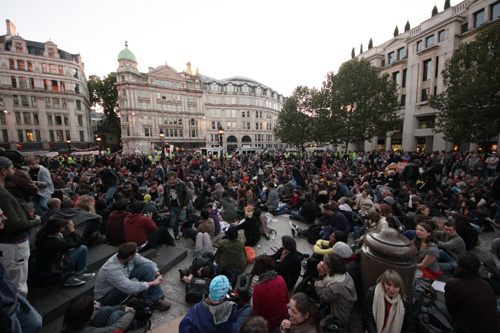
As the sun came up on the fourth day of the occupation, bleary-eyed protesters emerged from the hundred-or-so tents huddled in the shadow of one of London’s most iconic landmarks. They then made their way to the pop-up kitchen for a cup of tea and a hearty vegan breakfast. Overnight rain had done little to dampen the spirits of the activists, and the site’s mood was festive. A handful of police unobtrusively skirted the perimeters while passing city-folk looked on with interest, and journalists and camera crews wove among the tents. It looked a little chaotic, but the organization of the occupation was impressive. In a few short days and with no formal leadership, the occupation had set up structures to ensure that the occupation could be both effective and enduring.
Small working groups had been established to support specific initiatives ranging from food, medical, and legal committees to media and technical support. A generator provided power to make sure events could be filmed and ‘livestreamed,’ and a charging station enabled protesters to recharge their iPhones, cameras and computers. Volunteers circulated, picking up rubbish. There was even a library – nicknamed ‘Star Books’ – in front of the local Starbucks. An open-air canteen served up free food prepared by six trained chefs, its menu constantly replenished with donations from local shops or well-wishers with food donations.
There is clearly a long way to go before the London occupation gets to the same level of organization and support as the occupation in New York’s Zuccotti Park. In New York, ‘stations’ around the park provide information and services including sleeping bags, clothing and tooth paste, and the movement even publishes its own broadsheet newspaper – the Occupied Wall Street Journal. At the same time, the London occupation has drawn much of its inspiration from the Occupy Wall Street movement, using similar strategies and methods.
As in New York, protesters in London have successfully occupied a central site which provides a crucial practical and symbolic focal point for the movement. Many slogans used – such as “We are the 99%” and “Bankers got bailed out, we got sold out” – are the same and as in New York, two General Assemblies are held each day. The General Assembly, described as “a horizontal, autonomous, leaderless, consensus-based system,” allows anyone present to propose an idea or express an opinion. Decisions are reached by a show of hands. The method does not make for quick decision-making but as shown in Tahrir Square and Madrid’s Puerta del Sol, it can nevertheless be effective.
Over the past month the movement in America has spread across the country, garnering massive support. Fifteen of New York’s biggest unions have come out in solidarity and support expressed by respected celebrities and key political figures has included Joe Biden, Al Gore and Democratic House Minority Leader Nancy Pelosi. The London occupation has mustered support from Wikileaks founder Julian Assange and musician Billy Bragg.
As in New York, the vast majority of those camping overnight in London are young, but like Occupy Wall Street, the London occupation is also attracting people of all ages and backgrounds. “Since my grandson was born I’ve been forced to think about the sort of world he is going to grow-up in,” sixty-six year old pensioner Julie Wright from Coventry told me. “I am angry but this movement does give me some hope.”
A criticism regularly leveled at the movement both in America and in Britain is that it lacks focus and concrete goals. Indeed, ask each person outside St Paul’s Cathedral why they are there and you will get a different answer. You will hear talk about unemployment and welfare cuts, healthcare costs and environmental destruction, student loans and unfair taxation. But despite the multiplicity of issues raised there is an underlying cohesive sense of anger at corporate greed, government mismanagement and economic inequality.
So far the movement has not attempted to offer a clear set of solutions or a list of specific demands. While these may emerge, there is no sense of urgency to focus on anything now other than growing the movement. Addressing the General Assembly in Zuccotti Park on October 9th the political philosopher Slavoj Zizek acknowledged that “[t]here are truly difficult questions that confront us. We know what we do not want. But what do we want?” But Zizek is nevertheless energized by the movement. “The central message of is a clear one” he told the crowd. “We are allowed to think about alternatives.”
For those involved, the movement on both sides of the Atlantic is filled with optimism. But as the unseasonably warm October weather slips away and tactical differences become more pronounced there are dangers. “Don’t fall in love with yourselves” warned Zizek. “We have a nice time here. But remember: carnivals come cheap. What matters is the day after.” In New York there is much discussion around the question of what a “win” would look. Some argue that they have already ‘won’ while others believe that the movement has only just begun. In some ways, both positions are true; Occupy Wall Street has clearly succeeded in altering the America’s political topography. Time will tell whether the occupation in London, and others around Britain, will manage to do the same.
Stefan Simanowitz is a freelance writer, journalist and broadcaster. He spend a week in New York with the Occupy Wall Street Movement.
